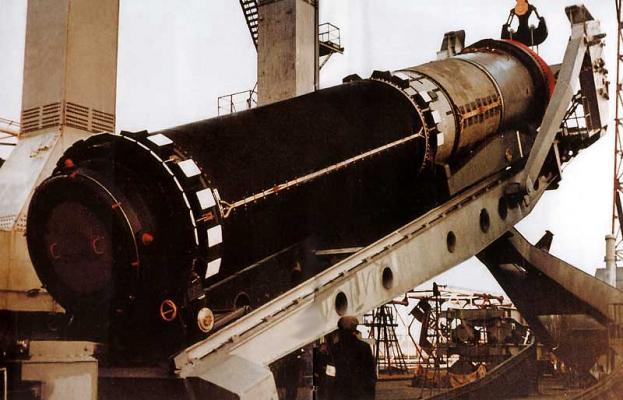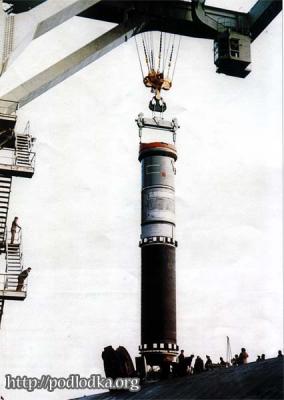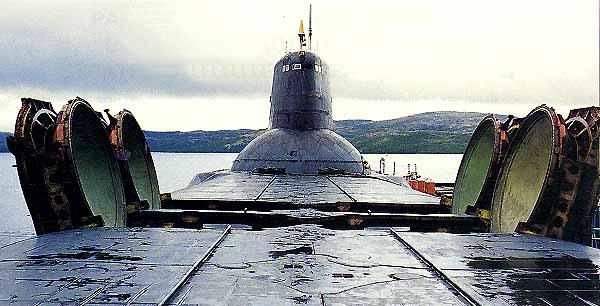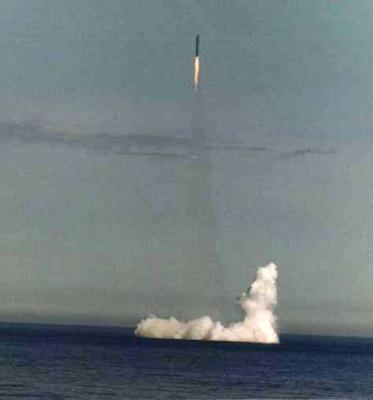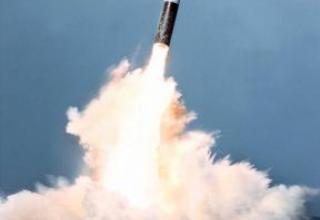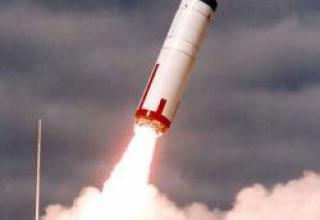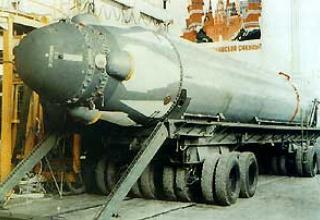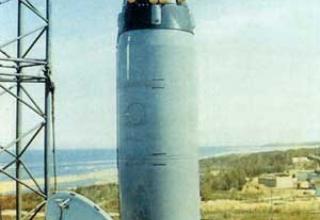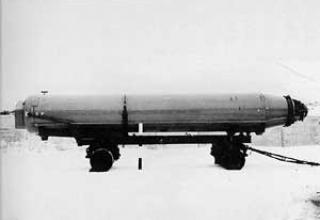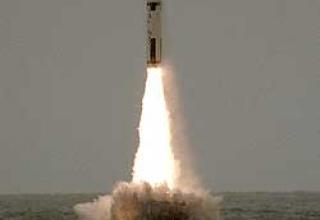The D-19 "Typhoon" strategic missile system, which includes 20 solid-fuel three-stage intercontinental ballistic missiles R-39 (3M65, RSM-52) with separable head units, was developed at the Machine-Building Design Bureau (now the State Rocket Center (GRC) named after Academician V.P. Makeev) in the period from 1971 to 1983 and adopted for service heavy nuclear cruisers such as "Shark" project 941 ).
The development of the missile began with the launch tests of full-scale mock-ups from the float stand and the experimental submarine K-153 of project 629, re-equipped under project 619 with a single mine. A total of 9 missiles were launched from a floatation stand and 7 from a submarine. These tests made it possible to test a submarine and surface launch from a "dry" mine under a powder pressure accumulator. During joint flight tests 17 missiles were launched from the ground test bench. More than half of the launches were unsuccessful due to the malfunction of the first and second stage engines. After the shortcomings were remedied, missiles were launched from the Shark submarine: of the sixteen launches, all sixteen were deemed successful. The first salvo fire of 4 missiles was carried out partially: for the fourth missile was a program cancellation of prelaunch training to exceed the parameters of normal start conditions (NUS) ship. The second salvo 4-rocket fire was successful. R-39 rocket launches at maximum range were held in September 1982.
After the completion of joint flight tests, the D-19 complex with R-39 missile and TK-208 head cruiser of project 941 underwent intensive operation, according to the positive results of which the D-19 complex was adopted for service in 1984.
In parallel with the creation of the RK D-19 and the construction of missile carriers was preparing the Northern Fleet ship base and technical base (TRB) storage of missiles, which were supplied from the plant to the fleet fully assembled. Due to the significant mass-profile characteristics of the missiles on the tubes were stored and delivered to the loading berth on the railway track. A special crane with a lifting capacity of over 100 tons was designed to load the missiles on ships. Two cranes were manufactured, mounted respectively on the berths of Severodvinsk and the missile carrier station. For transportation by sea and loading of R-39 missiles, a special rocket carrier ("Alexander Brykin" - project 11570) with full displacement of 11.440 tons was built, which has 16 containers for R-39 missiles and equipped with a 125-ton crane. Serious work was done to improve the combat control and communication system.
Tests carried out in the Northern Fleet in 1998 confirmed the high reliability of the D-19 complex, when the Typhoon submarine launched all its 20 DSM-52 missiles simultaneously.
The Typhoon system was not inferior in its combat characteristics to the American strategic system Trident-1. However, it was inferior to the Trident-2, primarily in terms of missile characteristics: weight and a half, the power of combat equipment in three and accuracy of target hitting twice. Therefore, after the adoption of the RK D-19 in service was immediately assigned to work on its further improvement, with the development of an improved version of the RK D-19UTTH (in the future - "Bark"). At the same time, it was planned to place this complex on six RPKSN and re-equipping them during the next repairs. In the process of forming the appearance of this complex, the further prospects for the development of marine ballast were determined. The main developer - Mashinostroyenia Design Bureau and the Institute of Armament of the Navy proposed the creation by the end of the 20th century of two solid-fuel missiles, one of which was equipped with the RSSCHIN (cipher "Ost"), the second - a monoblock, flight-controlled head unit (cipher "West"). These intentions were reflected in the draft Fleet Weapons Program (FP) for 1991-2000, which also included the design and construction of new missile carriers. "Bark" has a range of more than 10 thousand kilometers and carries 10 medium nuclear units. The design of the missile provided for a special system of passage through the ice, providing launch from under the ice shell of northern latitudes. Bark could also be used both on a normal trajectory and on the deck. In the first case, the missile flies from the Barents Sea to Kamchatka in 30 minutes, and in the second - in 17 minutes.
The departure in 1985 from the life of General Designer V.P. Makeev seriously affected the timing and quality of work on this complex. With the collapse of the Soviet Union and the subsequent sharp collapse of defense financing, work on the complex slowed down, which, of course, led to a decrease in completeness and failures during testing. In 1998, by the government's decision, the creation of the RK D-19UTTH was discontinued and the re-equipment of one missile carrier was suspended. In 1994, it was announced that the fourth generation missile carrier of the fourth generation was laid down at the SMP slipway. 955 "Yuri Dolgoruky" Ave., on which it was originally planned to place the RK D-19UTTH, and to build a series of such ships. After cessation of work on the complex D-19UTTH this missile carrier was reoriented to a new complex with solid fuel missile "Bulava".
In the west, the D-19 complex was designated SS-N-20 "Sturgeon".
Composition:
The R-39 missile (see diagram) includes a three-stage solid propellant carrier, a shock-absorbing rocket launch system (ARSS) and a missile combat stage (BSR) with 10 combat units.
The instrument cluster is located at the nose of the missile and joins the missile stage body with a flange joint, together they form a split head end. The instrument cluster consists of two hermetically sealed compartments, separated by an intermediate bottom: a three-stage gyrostabilizer compartment with an astrostabilizing device, closed by a dome drop-off in flight, and a control instrumentation compartment located on an amortized frame.
The dilution stage accommodates up to 10 combat units of 100ct each. A liquid propulsion system (LPU) is mounted on its hull, providing control of the missile when operating the 3-stage and individual pointing of combat units at targets, as well as a detachable third stage engine. The dilution rail is located around the third stage engine and consists of a multi-chamber liquid engine and toroidal-shaped fuel tanks. The liquid engine is a two-mode, open-mode engine with single operation and multiple switching from mode to mode. Control system - inertial, equipped with astro-correction equipment, which provides KVO drop points not worse than 500m at maximum range (see trajectory diagram).
The missile's marching engines have low relative elongation with minimal interstage compartments. The engine housings are made of composite material by winding the "cocoon" type threads and are equipped with solid fuel charges firmly fastened. The power sheath of the 1st stage - 3D65 DU body was made of high-strength SVM organofiber, titanium alloy VTV-1 was used for bottom elements. In the design of the first stage engine a stationary nozzle with eight valves for gas injection located in pairs due to the critical cross-section of the nozzle, providing control through all control channels, was used. The "inflatable" system provided high dynamic characteristics of the rocket. Mixed fuel charge with an internal channel of star-shaped development of NPO "Altai" provided a programmed thrust drop during 17 sec, which allowed to successfully solve the problem of the rocket controllability before separation of stages. Other design solutions were applied in the engine control system 3D65 due to the specifics of its application in the sea-based missile - complete sealing of the engine control system to prevent sea water from entering it, prelaunch air injection of the engine interior cavity to compensate the external hydrodynamic loads acting on the outer surface of the hull during the launch.
To minimize the size of the R-39 rocket for the first time in the practice of the domestic rocket industry for the engines of the second and third stages were used nozzle blocks with sliding telescopic sockets, as well as a number of advanced technical solutions for the thrust vector control system.
At the second stage, for creation of the moment of rotation in opposite planes two additional powder engines (which operating time was equal to operating time of a stage) were located. In order to create the torque they were synchronously turning left/right.
The problem of creating a minimum mass control system for the thrust vector, in particular the steering drive for the controls takes an important place in the development of solid propellant missiles. As a rule, solid-propellant missiles require a self-contained power source (energy) to power the steering linkage, so the steering linkage for solid-propellant missiles is about twice as heavy as for liquid-propellant missiles. In addition to the considerable weight and dimensions that complicate the placement of the drive in the limited dimensions of the rocket compartments, in systems with traditional steering machines, there is a problem of providing the required dynamic characteristics of the link steering machine - a nozzle, associated with a significant impact on them the rigidity of the elements of the engine design, the steering machine itself and the working body involved in the kinematic force transfer chain. Design and search studies to improve the thrust vector control system of the P-39 missile revealed that the most effective way to achieve high mass perfection and increase the reliability of such systems is to use multifunctional energy systems with a combined power supply based on gas-hydraulic steering machines.
For the D-19 complex, an original launch system was created with almost all elements of the launcher placed on the rocket itself. The P-39 is suspended in the mine, relying on a special shock-absorbing rocket and launch system (ARSS) on a support ring located in the upper part of the mine. ARSS provides the missile amortization, sealing the cavity of the mine and the safety of the missile for a submarine, allows the immersion of the missile carrier with the open shaft cover to a depth of 90m. All power elements of the missile required for its operation on land and on board the ship, except for the middle amortization belt placed on the MSO-1 (interstage compartment), are placed on the ARSS and the tail compartment hull, which are discharged at the initial section of the trajectory after the missile leaves the water. The missile is launched from a "dry" mine using a powder pressure accumulator placed at the bottom of the mine in the nozzle of the first stage engine. At the moment of launch, special powder charges located at the GGGZ (gas-jet protection gas generator) create a gas cavern around the rocket, significantly reducing the hydrodynamic loads in the underwater section of the trajectory. After leaving the water, the ARS is cut off by an elongated cumulative charge, removed by removal engines (3×12) and driven by the removal engine to a safe distance from the submarine. The command to start the first stage engine is given when the missile leaves the mine. When the first stage engine is not started after leaving the water, the missile is driven away for the safety of the submarine.
The entire ammo is launched in volley. The rockets can be launched from a depth of up to 55m when the sea waves up to 6 points, as well as from an above-water position.
New technical solutions implemented in the missile:
- rocket engines powered by high-energy solid fuel using new construction materials;
- a control system using the generalized astrocorrection principle;
- high-speed small-size combat units of high specific power;
- an amortization missile launch system providing for storage, transportation and launch of the missile;
- units of ground-based technological equipment on the railway track (with craneless missile transshipment) and a set of means of their loading, ensuring the safety of missile operation.
Characteristics:
| Start mass, t | 96±0.6 |
| Range of fire | 9400 |
| Maximum mass to be thrown, kg | 2550 |
| Number of steps | 3 |
| The length of the rocket, m | 16.05 |
| Diameter of the first and second rocket stages, m | 2.4 |
Testing:
On August 6, 1991, at 9:07 p.m., salvo fire was fired with a full set of RSM-54 missiles from the 667BMBM submarine. The operation received the code "Begemot". In order to reduce costs, the operation was carried out for scheduled combat training of the submarine crew and regular flight of only two missiles. The missiles, which started in the first and last volley, had to complete the full flight program and hit the specified aiming points. The other missiles taking part in the salvo should have fully corresponded to the combat missiles in all the launch parameters, but the height of their flight could be arbitrary. To carry out the volley full ammunition was allocated submarine Novomoskovsk (commander of the boat SV Egorov) and 16 missiles RSM-54, manufactured by the Krasnoyarsk Engineering Plant. The launch was a success, so far no one in the world has been able to repeat the firing with full ammunition.
On June 5, 2001 the Northern Fleet's 667BMBM project (commander - 1st rank captain Mikhail Bannykh) successfully launched a ballistic missile from the Barents Sea. The missile was launched from an underwater hollow. The head of the rocket at a given time hit the target at the Kura test site in Kamchatka.
Sources:
- "Баллистические ракеты подводных лодок" избранные статьи, под общей редакцией доктора технических наук И.И. Величко
- Морские стратегические ракетные комплексы. М., "Военный парад", 2011 г.
- В.П. Кузин, В.И.Никольский Военно-Морской Флот СССР 1945-1991. СПб, "Историческое Морское Общество". 1996
- А.Б. Широкорад Оружие отечественного флота 1945-2000. Минск,Москва, Харвест АСТ, 2001
- Ильин В.Е., А.И. Колесников Подводные лодки России: иллюстрированный справочник. Тверь, Издательство Астрель, 2001
- С.Н. Ковалев.О создании морских стратегических ядерных сил. "Судостроение" №2 2001 г.
- Владимир Заборский "Холостой замах "Булавы"
- Виктор Литовкин "Синева" поднимется над морем"
- www.flot.com
- Ф. Новоселов "О создании самой мощной стратегической системы морского базирования было объявлено на ХХVI съезде КПСС"
- http://www.submarine.logicsystems.ru
- www.submarine.ru
